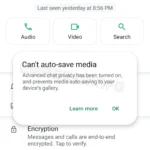![]()
Google Messages is used by more than a billion people daily for communication. We have thus made security a primary concern, incorporating strong on-device filters driven by AI and cutting-edge security to shield users from the 2 billion questionable communications they get each month. You can have private talks with other Google Messages RCS users using end-to-end encrypted RCS communications. And we’re not going to stop there. To keep your Google Messages interactions even more private and secure, we’re dedicated to continuously creating new features and controls.
The improved security function moves potentially suspect communications to a spam folder and uses machine learning to notify consumers of these spam texts. Google is introducing a number of new features in its Messages app to enhance user privacy and spam prevention.
A number of new features are being introduced by Google texts with the goal of enhancing user privacy and shielding users from dubious calls and texts. Using artificial intelligence (AI) models, one of the enhancements is protection against scam SMS about jobs and parcel deliveries. Features for managing foreign calls and contact verifications are also included. Later this year, the messaging platform plans to extend its intelligent alerts about potentially hazardous links to the entire market.
The new features in the Google Message
Google described the additional capabilities that would be added to its Messaging app during the month-long cybersecurity awareness campaign.
- Enhanced Spam Protection: A new function that can automatically shift potentially fraudulent text messages regarding package delivery or jobs to the spam folder will be available to beta users of the Messages app who have spam protection activated. It is claimed that this function uses on-device machine learning (ML) to recognize and categorize the talks. Google asserts that until a text message is flagged as spam, it will stay private.
- Sensitive Content Warnings: Sensitive Content Warnings are now an optional feature in Google’s Messages app. It gives consumers alternatives, such as viewing the material, and blurs obscene content. It alerts users to the dangers of transmitting explicit material by displaying a warning when they attempt to forward the content to others. According to the business, the entire procedure takes place on the device, protecting user privacy and end-to-end encryption. Google Messages’ Sensitive Content Warning is opt-in for users above the age of 18 and opt-out for those under that age.All of this takes place on-device to safeguard your privacy and ensure that only the sender and receiver can access the content of end-to-end encrypted messages. Google is not aware that nudity may have been identified in your photos while you have Sensitive Content Warnings enabled. Adults may opt-in to this function through Android Settings, while those under the age of 18 can opt-out. In the upcoming months, Android 9+ devices—including Android Go devices with Google Messages—will start to get Sensitive Content Warnings.
- Protection Against International Senders: Soon, text messages sent by unknown overseas senders will be automatically hidden in Google Messages. The Spam and banned folders will be used to store the messages. Later this year, Singapore will launch this capability as a test project before it is progressively extended to other areas.
- Potentially Dangerous Links: The software giant, located in Mountain View, is now conducting a trial program in India, Thailand, Malaysia, and Singapore that censors and warns users about potentially harmful links they get in messages from senders they don’t know. Later this year, this feature will be made available on a worldwide scale.
- Contact Verification: Contact verification is another function that is being introduced on the messaging platform. Before texting a contact, users will be able to validate their identity by using their public keys. Google is creating a single public key verification mechanism that uses number comparison or QR codes to accomplish this. Next year, Android 9 and later smartphones will be able to use this functionality.
Discover more from TechBooky
Subscribe to get the latest posts sent to your email.















